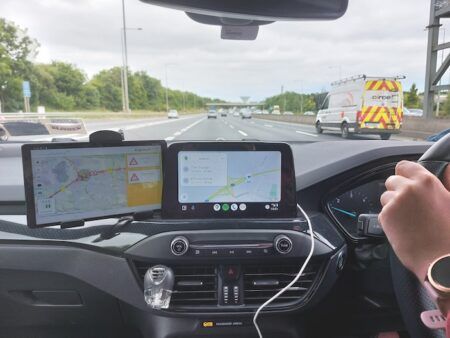Road user charging (RUC) is a funding mechanism that taxes vehicle owners based on how many miles they drive, instead of collecting fuel taxes or charging toll road fees. Similarly to several US states, Norway is currently discussing and testing RUC programs. Aventi is one of the leading advocates for RUC in Norway. The company is co-organizing a nationwide two-year pilot project called Pilot-T ASAM, which tests Aventi’s RUC technology on simulated cars as well as real vehicles. Here’s why RUC is such a pressing topic in Norway and how Aventi uses the Smartcar API to build, test, and scale its industry-leading RUC solution.
Norway’s problem with fuel taxes and toll road fees
Similarly to the US, the Norwegian government charges vehicle owners taxes on fuel purchases, vehicle registrations, and toll roads. Those taxes are supposed to cover the cost of building and maintaining Norwegian roads, and they are supposed to be fair for everyone. Unfortunately, the country is facing two problems with this current approach.
The government loses more money every year
First, the Norwegian government collects less and less money from fuel taxes every year. Part of the reason is gasoline and diesel cars, which become more fuel-efficient with every generation. At the same time, electric vehicles are taking a bigger market share every year. In 2019, 42.4% of new car sales were electric vehicles and 25.9% were hybrids. This trend doesn’t stop at new vehicle sales alone. Almost 10% of all passenger cars that are driven in Norway today are electric. The government’s goal is to get this number to 50% within the next 10 years. Sooner or later, Norway has to find a way to compensate for the increasing loss of government income from fuel taxes.
Expensive toll road fees upset Norwegian citizens
The second problem Norway faces is an increase in toll road fees. The fuel taxes and vehicle registration fees that the national government collects every year are not only earmarked for road construction and maintenance but for other purposes, too. Once a year, the national budget decides how much of those funds will be set aside for road construction and maintenance. It can thus take years and sometimes decades until the construction of a new highway, bridge, or tunnel gets approved. Many cities and counties have found a way to avoid this lengthy process. Instead of waiting for funding from the national government, they have introduced toll road fees that directly fund the construction of new roads.
The Norwegian population is increasingly frustrated by these constantly increasing and unfair toll road fees. A typical family of four can end up paying $180 per month if they happen to live on the wrong side of the toll road gantries. The topic has spawned protest marches and even the creation of a new political party.
Road usage charge: a sustainable and equitable solution
All political parties in the Norwegian parliament, except one, are in favor of exploring RUC as a replacement of toll roads. In contrast to toll roads, RUC is a tax that would be applied to the use of all roads in the country, not only certain ones.
The Norwegian Institute of Transport Economics suggests that RUC should replace not only toll roads but fuel taxes and vehicle registration fees too, as RUC alone would be sufficient to cover all road construction and maintenance costs in the country. The institute also states that RUC should vary based on a vehicle’s environmental footprint and axial load as well as the area (e.g. population density) and time (e.g. rush hours) at which a car owner is driving.
 The Norwegian Research Council is funding two ongoing pilot projects to build and test technical RUC solutions. One of the projects, called Pilot-T ASAM, is a collaboration between the research organization SINTEF, the Norwegian Public Roads Administration, and Aventi.
The Norwegian Research Council is funding two ongoing pilot projects to build and test technical RUC solutions. One of the projects, called Pilot-T ASAM, is a collaboration between the research organization SINTEF, the Norwegian Public Roads Administration, and Aventi.
The Pilot-T ASAM project
Aventi is a road infrastructure company that offers a digital platform for Cooperative Intelligent Transportation Systems (C-ITS). C-ITS allows cars to communicate with each other (V2V communication) as well as with their surrounding road infrastructure (V2I communication).
Since the Pilot-T ASAM project started in July of last year, Aventi has developed and tested its RUC solution on real vehicles across the country.
“The goal of our RUC program is to provide a fair and accurate tax solution,” said Aventi Systems Engineer Bjørn Elnes. “At the same time, we want to reduce traffic congestion and incentivize environmentally-friendly driving habits.”
To achieve this goal, Aventi follows the Institute of Transport Economics’ suggestion to charge vehicle owners different rates depending not only on their mileage but also on the type of car, location, and time of driving. For example, drivers of fuel cars pay more than EV owners, drivers of large trucks pay more than those who own small passenger cars, and people who drive in urban areas during rush hours pay more than those who drive in rural areas during off-peak hours. Aventi calls this pricing model “dynamic pricing with green geofencing.”
“This approach is unique to RUC programs in Norway,” said Elnes. “Most other countries charge a flat mileage fee that doesn’t vary based on the type of vehicle, location, or time.”
Using C-ITS to build a powerful RUC solution
Ideally, Aventi wants to use C-ITS technology to build their entire RUC program. This includes monitoring a vehicle owner’s type of car, mileage, location, and time of driving. Aventi aims to use Service Announcement Messages (SAMs) to retrieve these pieces of information from each car. SAMs are messages that the road infrastructure sends out in order to inform vehicles of available traffic services, enforcements, or fees. In the US, SAMs are often called Wireless Access in Vehicular Environment (WAVE) Service Advertisements.
“In the future pan-European C-ITS road network, SAMs will allow vehicle owners to receive notifications about vacant charging stations, booked parking spots, and more,” Elnes said. “RUC is one of the most promising use cases.”
Incompatible cars and unreliable smartphone telematics
Unfortunately, not all cars are able to send and receive SAMs just yet. C-ITS is still a new technology and only very few vehicle models are equipped with so-called C-ITS Onboard Units (OBUs), allowing them to receive SAMs and respond with relevant data. Aventi decided to rely on data from a car owner’s smartphone in addition to OBUs until C-ITS technology gets more widely adopted.
When they first started incorporating smartphone telemetry data into their RUC solution, Aventi’s engineers discovered yet another challenge. The data that smartphones report is rarely accurate, and even if it is, Aventi’s engineers can never be sure which specific vehicle the device is located in.
Smartphone telematics is a common way to track vehicle mileage, especially in the auto insurance industry. However, the mileage that smartphones report is often incorrect. Smartphones calculate vehicle mileage by monitoring movement and detecting the start and end of a car trip. It commonly happens that a device reports a trip, although the smartphone holder isn’t driving but riding in someone else’s car or taking the bus. Sometimes the device even fails to detect the start or end of a trip. Finally, vehicle owners can happen to forget their phones at home, or their phones can lose service in the middle of a trip.
In addition to reporting inaccurate mileage data, the use of smartphone telemetry posed a problem for Aventi’s dynamic pricing model. The success of the pricing model entirely depends on the ability to determine which type of car (e.g. large or small, fuel or electric) a vehicle owner is driving. With smartphone telemetry data, it is impossible to know exactly which vehicle a device is located in.
“If you don’t have a way of checking which car the phone is in, you could say that you are driving an electric car, but in reality, you can take your diesel truck,” Elnes said.
When Aventi’s engineers looked to solve these problems, they came across the Smartcar API, which allows applications to retrieve information from cars with the vehicle owners’ consent.
“It seemed like our C-ITS technology wasn’t quite ready for the broad market yet, and the smartphone telematics approach was just not working out for us,” Elnes said. “We found Smartcar and we thought: let’s give it a try!”
Aventi has since been using the Smartcar API to verify and complement information from OBUs and smartphones. The company uses Smartcar to locate vehicles, read their odometer, and retrieve their make, model, year of production, and VIN in order to verify exactly which car a person is driving at a given time.
The Smartcar platform is compatible with most new vehicle models. As it communicates directly with each vehicle’s embedded telematics system, it returns actual, accurate information in real-time. This has helped Aventi alleviate all of the challenges involved in using C-ITS technology and smartphone telematics.
 The key that unlocks the RUC door
The key that unlocks the RUC door
In addition to providing accurate, real-time vehicle data for their RUC program, Smartcar has enabled Aventi to build their RUC solution effortlessly, with only one single integration for all compatible vehicle brands.
“We see that there is a lot of time and effort being put into creating deals with OEMs to gain access to their APIs. If every service provider had to do the same amount of work, it just wouldn’t be economically feasible,” Elnes said. “In that sense, Smartcar is acting as a key for opening the gate to extensive information from all cars.”
Aventi expects to further test and improve its RUC solution until the Pilot-T ASAM project ends in July next year. The Norwegian government will then decide whether to adopt the program nationwide.
This article was written by Charlotte Kosche a senior content writer at Smartcar





